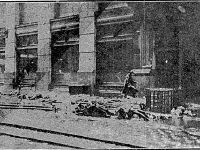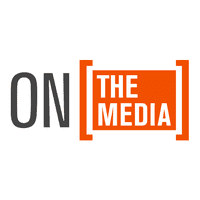Triangle Shirtwaist Factory

BROOKE GLADSTONE: One hundred years ago Friday, the Triangle Shirtwaist Factory in New York’s Greenwich Village caught fire on a late Saturday afternoon. Hundreds of workers, young women, mostly Jewish, mostly immigrant, were trapped on the upper floors, crammed onto a fire escape or piled on the roof waiting for the horse-drawn fire engines to arrive. David Dubinsky was a teenager when it happened. On the 50th anniversary, as head of the International Ladies Garment Workers Union, he commemorated the fire.
DAVID DUBINSKY: We gather here today to pay homage to the memory of the 146 who died here in flames, leaping from the windows, crashing to the sidewalk, screaming to death behind the locked doors. These were our martyrs.
BROOKE GLADSTONE: All in all, 146 people fell or jumped to their death or died in the fire, and more than 70 were injured. Of course, in 1911 there were no broadcasts or digital media, but there was print coverage, many newspapers each offering a unique spin on the tragedy. As we investigate the charges of bias in public radio, we thought it might be useful to consider an earlier era when, according to David Von Drehle, politics and prejudice were an overt influence on the news. Von Drehle, author of Triangle: The Fire That Changed America, looked at William Randolph Hearst’s The American, Joseph Pulitzer’s The World and The New York Times. And he says the first thing he noticed was what wasn't in the coverage.
DAVID VON DREHLE: The papers were fantastic on breaking news. Their writing styles were very exciting, very vivid, very powerfully voiced. But their attention span was so short because they were always onto the next story, looking for the next sensation. And so, the kinds of stories that I'd come to expect through a career in journalism, the deeply reported stories of the victims, the takeout features, the minute-by-minute reconstructions, who these people were, what brought them to this moment, was nowhere because within four or five days the papers were moving onto the next story.
BROOKE GLADSTONE: So let's talk about what was there, and we can start with Hearst’s The American. What sort of paper was it? Who read it? What was its tone, and what was its message?
DAVID VON DREHLE: The Hearst paper was a sensational paper. It was originally called The Examiner and he renamed it The American in honor of the Spanish-American War, which he’s often credited with sort of ginning up. It was obsessed with gory crimes and the affairs of European royalty.
BROOKE GLADSTONE: Now, this was a, a penny paper. The assumption there was that it would appeal to working people, right?
DAVID VON DREHLE: To working people. And, by this time, it had become the engine of Hearst’s own political ambitions. He wanted to be President of the United States, and the pathway in those days, at the turn of the century, was through New York. Grover Cleveland, Theodore Roosevelt, they'd cleaned up New York and gained national prominence and ridden that to the White House, and Hearst wanted to do the same thing. And when the fire came, The American advertised William Randolph Hearst’s solution to the problems of workplace safety. He convened his own panel. Every day the headlines were “American Fire Panel Convenes” across the top of the front page.
BROOKE GLADSTONE: I mean, to be fair, the working conditions there led directly to that tragedy. And the doors were locked. The girls couldn't get out. They couldn't even pick up the lint that was there that was so flammable, because they'd be accused of stealing it, right?
DAVID VON DREHLE: The workplace conditions, the lack of safety laws directly led to the tragedy, no doubt about it. But rather than trying to pin that responsibility on any person actually responsible, the Hearst approach was to show what he would do if he were mayor. And that, in a sense, didn't lead anywhere because ultimately Hearst was not mayor.
BROOKE GLADSTONE: Well, Hearst’s fiercest competitor all along was Joseph Pulitzer. His was also a people’s paper, right, The World? So how did his coverage contrast with Hearst’s?
DAVID VON DREHLE: The World was a fantastic newspaper. It really was the best newspaper in New York at the time. But it also had a very strong political point of view. The World had become the sort of publicity arm for an ambitious new district attorney in New York, Charles Whitman. Whitman was another one of these people who was going to clean up New York and become President. And the star reporter at The World, a young guy by the name of Herbert Bayard Swope, was essentially Whitman’s publicity agent. In fact, there’s a wonderful scene where Whitman is in a meeting with other reporters from other papers at the time that the fire breaks out, and Swope comes rushing into the room waving his arms, you know: That’s enough, boys. The Triangle building’s on fire, and I think the DA should be there. And they rush off together arm in arm. Later Swope sort of prepares Whitman’s remarks on the fire. And so, they very much were backing Whitman, and Whitman’s strategy was ultimately to go after the owners of the factory, Max Blanck and Isaac Harris.
BROOKE GLADSTONE: And?
DAVID VON DREHLE: Well, ultimately Blanck and Harris hired the best lawyer in New York, Max Steuer, a fantastic character, who got them off in a three-week trial.
BROOKE GLADSTONE: Let's talk about The New York Times, at the time, very conservative, very anti-labor. How did they cover it?
DAVID VON DREHLE: The Times wrote sober editorials where they said things like, obviously, we need to investigate this, obviously, we need to think about it and talk about it, but probably no real changes are necessary. They were very much in line with the idea that – which was completely prevalent in American society in those days – that these things just happen, that they're almost like acts of God and can't be prevented. All the mine collapses and railroad derailments and ships sinking and all the ways that workers were dying in the early industrial era, nothing could really be helped about it.
BROOKE GLADSTONE: You were gonna read something?
DAVID VON DREHLE: Yeah, a totally typical Times editorial would go like this: “Excited persons rarely accomplish anything. Trust Charles Whitman, the DA, a man of good judgment and quick action. No new laws are needed.” That was the one thing they were sure of.
BROOKE GLADSTONE: How quickly did the papers, all of them, move away from this as a front page story?
DAVID VON DREHLE: There was a huge public gathering one week after the fire that made front page news, and that was the end of the Triangle on the front pages. I, I –
[OVERLAPPING VOICES]
BROOKE GLADSTONE: What about Hearst, who had his big reform program going?
DAVID VON DREHLE: He, he completely lost interest in the reform program, really when Tammany Hall, his great bane in life, became interested in reform. See, the striking thing about the Triangle story - why does this disaster matter, out of all the industrial disasters of that period? It was because these workers were organizing. They were voting. They were voting for William Randolph Hearst, for example. And Tammany Hall, which ran the city, which was always opposed to reform, up to this time, realized they needed to appeal to these new voters, or they were going to lose control of the city.
BROOKE GLADSTONE: Tammany Hall was a incredibly corrupt political machine. In fact, it’s almost synonymous with political corruption.
[OVERTALK/BOTH AT ONCE]
DAVID VON DREHLE: With political corruption, that’s exactly right. And so, no one expected them to do anything. And when they said, we're interested in taking on this reform, the real reformers were immediately skeptical that something was up, that Tammany was gonna bury this somehow. But instead, the boss of Tammany Hall, Charlie Murphy, put his two best young men in charge of it in the state legislature, a guy named Al Smith and a guy named Robert Wagner, two names that are, you know –
[BROOKE LAUGHS] - legendary in New York. Over the next three years they passed the most sweeping agenda of workplace labor reforms in the country. And it was hugely popular, and they rode that to careers that changed America. Robert Wagner really was the author of the New Deal.
BROOKE GLADSTONE: Well, this is ironic because change happened after the Triangle Shirtwaist Factory, because of the newspaper coverage. But the coverage that Tammany Hall responded to was really just the political ambitions of a publisher, of William Randolph Hearst, not because of this shocking tragedy but just because they saw Hearst potentially eroding its power base.
DAVID VON DREHLE: In 1905, Hearst had beaten them at their own game. He had gone into the Lower East Side working class neighborhoods of New York, and he had beaten Tammany Hall. That had never happened. They had to steal votes, literally throw ballot boxes into the East River to hold onto City Hall that year.
BROOKE GLADSTONE: So, all this coverage, absent Hearst’s ambitions, might not have accomplished anything good.
DAVID VON DREHLE: It’s true, it’s true. But let me just turn it slightly, because Tammany Hall didn't give this to the workers of New York. They earned it. They organized, they went out on strike, they did picket lines. They appealed in ways that spoke to other classes, other types of voters, spoke to the rich progressives of New York. They formed coalitions. And, most of all, they voted. And that’s what Tammany respected, was votes.
BROOKE GLADSTONE: It strikes me, listening to you, that the media are the same as they ever were. You see an unholy closeness between a politician and a leading reporter at the Pulitzer paper. You see the political ambitions of a publisher skewing the coverage at the Hearst paper. You see a - entrenched conservatism urging no action at another paper. And at all of them you see what you referred to as an incredibly short attention span, something that some people blame on the digital age. So what do you think? Are we just merely recapitulating media, as it’s always been?
DAVID VON DREHLE: I really think we are. I think 20, 30, 50 years from now, when we look at media history, we're going to look at the late 20th century as the aberration. It was created artificially by the scarcity of broadcast -frequency. The people who had that broadcast frequency created enormous monopolies, and with monopoly they had to speak broadly to huge audiences. What kind of journalism does that create? That creates a journalism of the middle. Now we're just back to the way it was before, when anybody with some verve could start up a publication and get it out there, and if it spoke to people, it would grow. Papers would take off, become hugely popular, and vanish almost overnight back in those days. And what does that kind of environment create? It creates point of view, it creates voice, it creates partisanship.
BROOKE GLADSTONE: So should we worry, or should we just calm down?
DAVID VON DREHLE: I'm in favor of calming down, as long as we understand what this environment means. It means that you can't trust every word you hear out of a speaker or a television set or your computer. And back in those days, you know, people who read the papers, they knew what Hearst was up to, they knew what Pulitzer was about. They knew The Times represented this and The Telegraph represented that, and The Herald represented still another thing. And that kind of savvy media consumer is what we're going to have to re-grow in the era we're in now.
BROOKE GLADSTONE: David Von Drehle, thank you very much.
DAVID VON DREHLE: My pleasure.
BROOKE GLADSTONE: David Von Drehle is editor-at-large for Time Magazine and author of Triangle: The Fire That Changed America.
[OTM THEME MUSIC/MUSIC UP AND UNDER]

